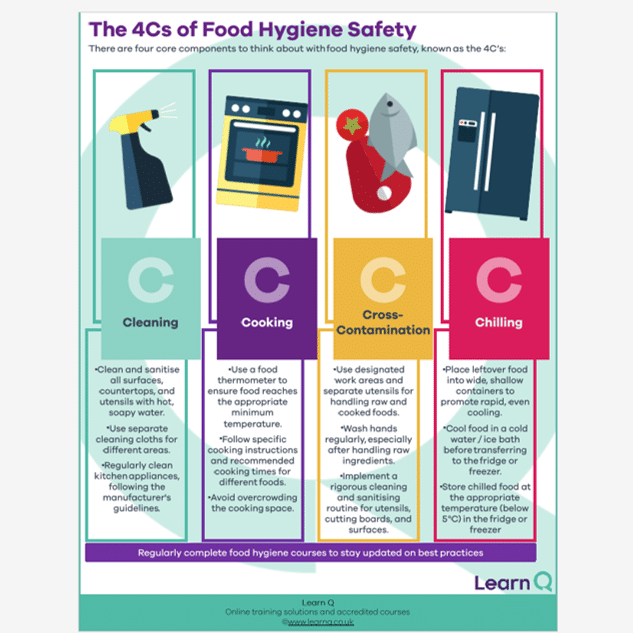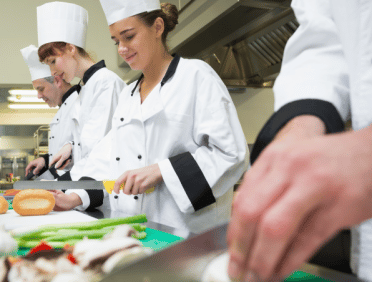Food hygiene safety is a core part of business. If you are a company that handles or sells food, you need to understand how food hygiene safety works.
There are four core components to think about with food hygiene safety. These are known as the 4C’s.
Click here to download Learn Q’s FREE 4Cs of Food Hygiene Safety Poster
Cleaning
Being able to keep surfaces clean and tidy is a core part of food hygiene safety. Not only does this help to guarantee the health and safety of your customers, but it also prevents the spread of pathogens in the workplace.
There are germs which are capable of living outside the human body for months at a time, which means that they need to be destroyed as quickly as possible, in a very thorough manner. This mandates the need for suitable cleaning practices.
You should always disinfect and clean an area immediately after food preparation has taken place in it. This is very important for health and social care, because you are likely to be interacting with high risk groups. However, this is just as valid everywhere else.
Your employer is responsible for making sure that you have the skills required to keep your team and your customers happy and in good health. As such, they have a responsibility to provide you with access to a food hygiene course to deliver the necessary health and safety training.
Cooking
Once food has been prepared, you have to make sure that it is cooked properly before you serve it to people.
In a busy kitchen environment, it can be very tempting to put everything into the oven and cook it at the same temperature for the same time. However, there are lots of food items that have specific cooking instructions, and you need to follow them to the letter in order to guarantee health and safety.
A particularly important example could be meat, which cooks at different temperatures depending on what kind of animal you’re dealing with. If you don’t read the packaging and cook the meat at the right temperature for the right time, you risk serving raw food which will cause food poisoning or other illnesses.
A food hygiene course on cooking can be a good thing to do. It might not seem like there is a lot to learn, but it’s important to take a refresher course every now and then. A popular example is that people often forget you need to serve meals above 63°C to prevent germs from contaminating food.
If you work somewhere like a health and safety environment, then you can’t assume that everybody knows the basics without stopping to check.
Cross-Contamination
A serious problem in busy kitchen environments is often food poisoning because health and safety concerns are forgotten in the rush.
The problem typically begins with badly cleaned utensils or hands which help to spread bacteria from one station to another. The end result is that someone gets sick.
Good hygiene has to be a fundamental part of health and safety in the kitchen environment to protect both staff and customers from sickness and disease. Therefore, it’s important to practice good hygiene by teaching staff how to do it for themselves, and to reduce contact with pathogens.
Obviously, it’s impossible to remove all bacteria from food, but the correct training can help to reduce the potential risk to those who are purchasing food from you. As an employee, you have a certain degree of personal responsibility for your own hygiene of both yourself and the station you work at.
Employers have a responsibility to provide staff with access to a food hygiene training course which will help them to learn the basics on separating cooked from raw food, and maintaining proper cleaning standards to prevent cross-contamination.
Chilling
Once you have prepared or served your food, good health and safety does not finish there. It’s important to make sure that you practice good food handling by safely storing any leftover food items that you may have at the end of the day.
The bulk of cooked food will be separated and put in storage, either in the fridge or the freezer. However, you need to make sure that you allow food at the chance to properly cool down before you put it into a cold environment, otherwise you can create diseases.
The best thing that you can do is to take your leftovers and divide them up into smaller portions, putting them in a wider dish. This helps to accelerate the cooling process and is a good way to reduce the temperature of food quickly to store it.
Your employer has a responsibility to provide suitable equipment to achieve the cooling process, and to provide you with basic training in the form of a food hygiene course that will teach you necessary techniques.













